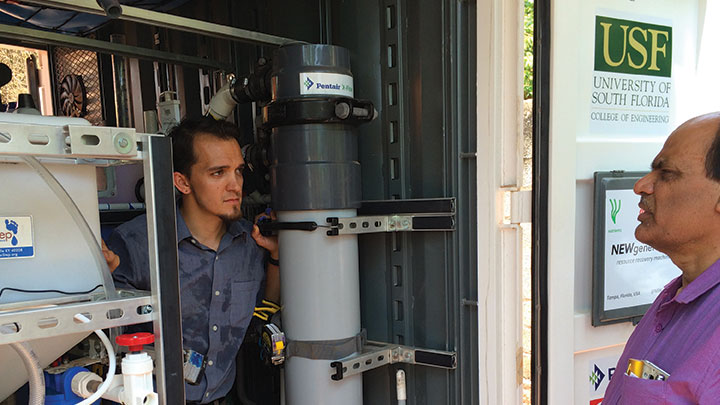Current Features
Protecting Our Water
By Lindsay Peterson, PhD ’16
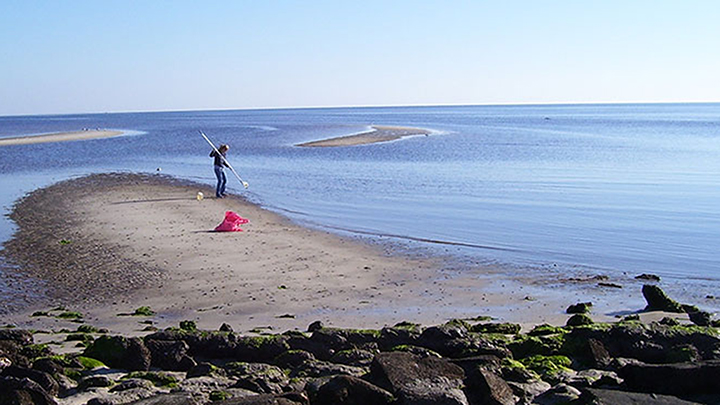
Water.
The word itself is believed to be as old as human language, speaking to its essential role in our survival.
Water makes up roughly 60 percent of the human body. It covers 70 percent of the world.
It’s part of an eternal cycle, rising from the ocean into the atmosphere, then falling to the ground as rain, where it gathers underground and in lakes, streams, and rivers, eventually to flow back into the ocean. Along the way, we use it to live.
We require water not only for drinking but for every aspect of our lives, from the growth and preparation of our food to the functioning of an economy that needs water for creating energy, operating a tourist resort and myriad other functions. And it touches us in ways that aren’t always evident, down to the microbial level.
As the world becomes more crowded, the safety and supply of its water faces multiple challenges, both naturally occurring and man-made, many of them potentially disastrous. But scientists at USF have tracked the changes and applied their years of knowledge, whether in chemistry, microbiology or marine biology. Here’s a look at what several of them are doing to detect the threats and find solutions.
Bacteria detective
When you think about dangerous, antibiotic-resistant bacteria, like the Staph bacteria known as MRSA, you probably think of a hospital or other health care facility.
Valerie Harwood, USF professor of integrative biology, suggests you think again.
Harwood is a bacteria detective. She and the researchers in her lab track down microorganisms that pose threats to our water supplies.
Their recent work examined the consequences of a 2014 sewer line break in St. Petersburg. When they investigated the water at the spill site, they found antibiotic resistant bacteria rarely found outside health care facilities.
Antibiotic resistance is one of the country’s most serious health threats, sickening more than 2 million people a year and resulting in 23,000 deaths, reports the U.S. Centers for Disease Control and Prevention.
It is not just a health facility problem, Harwood says. It is a water supply problem.
USF graduate student Suzanne Young led the investigation of the St. Petersburg spill. The bacteria they found is called vancomycin-resistant enterococci (VRE). The antibiotic vancomycin is a “last-resort” treatment for infections that don’t respond to other antibiotics. The CDC lists VRE as a serious threat.
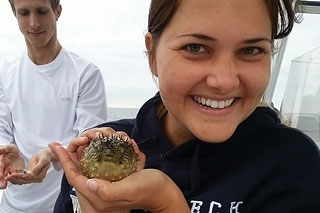
The researchers sampled the water and soil near the site for seven weeks after the spill, which released about 500,000 gallons of untreated sewage into an area near Boca Ciega Bay. They detected genes from VRE for nearly two weeks afterward, according to their paper published last July in the peer-reviewed journal Applied and Environmental Microbiology.
Harwood and Young didn’t expect to find VRE in the drainage ditch at the spill site, which was 2.6 miles from the nearest hospital, whose sewage flowed away from the site. Harwood called the discovery “quite concerning.”
Her worries focus largely on the discovery of a gene in the VRE that could spread to another bacterial strain. “One of our big fears is that genes that confer this (antibiotic) resistance are mobile” and could jump to another, more dangerous, pathogen.
This is what motivates Harwood and the others in her lab, where they study the genes of bacteria and viruses to track them to their source.
For Harwood, the work started when she was at the University of North Florida in 1996, and the City of Jacksonville was trying to figure out the source of fecal contamination in one of the local rivers. She didn’t know the answer; this wasn’t her specialty at the time. But one of her students brought her a paper on how to use antibiotic resistance patterns to trace fecal contamination back to its host. It launched her on the path that led to USF and the creation of her microbial source tracking lab.
She’s become an expert on the increasingly complex methods for identifying bacterial DNA, which is why Young came to USF from Barnard College in New York. She saw Harwood’s name on the lab manual for an environmental sciences class in 2011.
The lab work is intensive, but it has a clear real-world application. Harwood assists government agencies and others when they detect fecal contamination in water bodies and want to know where it came from.
The Reedy Creek Improvement District in Central Florida provided funding for Harwood’s lab to determine a bacteria source it detected. She was able to show it originated with area wildlife, not humans, which spared the district a regulatory headache.
Not all the problems are so benign, as the St. Petersburg spill demonstrated. Harwood worries about increasing contamination as growth continues and aging water systems come under more stress.
And she worries that people take their water supplies for granted.
“Clean water for people is going to come more and more at a premium,” she says. “The more we understand what affects water quality and how to mitigate problems, the better off we will be as a society.”
But first, people need to see it’s a precious resource, “not something to squander.”
Tracking the oil
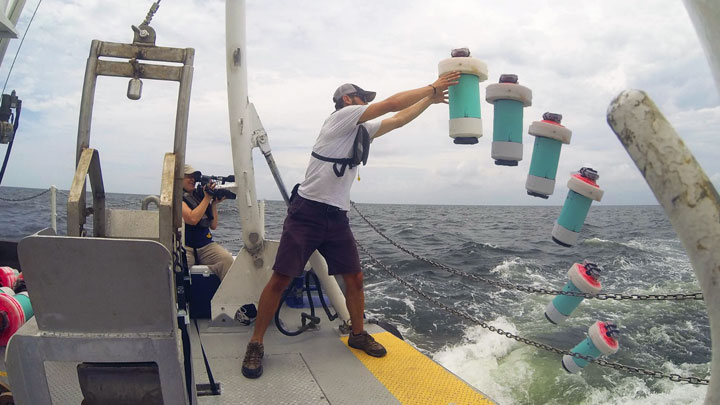
While not forgotten, the Deepwater Horizon oil spill no longer dominates Floridians’ attention as it did in the spring and summer of 2010, when 210 million gallons of oil gushed into the Gulf of Mexico after an oil rig explosion.
Not so for Steve Murawski, a professor in the USF College of Marine Science.
It’s at the surface of his mind nearly every day. Since coming to USF in 2011, he has worked to bring in more than $30 million in grants to study the spill’s effects. There’s good news, in that the Gulf continues to sustain a great deal of life. But there was lasting damage – and it could happen again.
“I hate to say it, but it’s likely that some other accidents will happen,” he says.
That’s because of the nature of ocean oil drilling. The risks increase as drillers go deeper in search of the oil. And Murawski, who directs the Center for Integrated Modeling and Analysis of Gulf Ecosystems, wants the research community and industry to be ready for whatever comes.
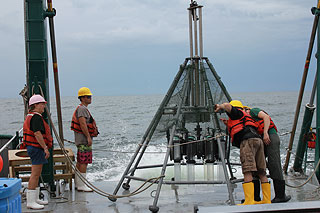
He started at USF amid the distress and urgency of assessing the Deepwater spill’s impact. He’d had a long and successful career with the National Marine Fisheries Service of the National Oceanic and Atmospheric Administration (NOAA). But this was a chance to study an unprecedented threat to the health of the Gulf of Mexico, which supported fishing and tourist industries worth billions in Florida alone.
The event began with an explosion that killed 11 crew members, destroyed the rig, and allowed crude oil to gush from the ocean floor. Because the well was so deep, it took the company in charge of the drilling, BP, 87 days to cap it.
As oil spread across the Gulf surface, a massive effort began to protect beaches and wetlands from Louisiana to Florida. Part of this involved BP’s use of a chemical dispersant, Corexit, which marine researchers soon realized created underwater plumes that snaked into the canyons and shelves where ocean life fed and spawned.
The spill devastated animal communities along the coast and exposed fish and corals and other bottom-dwelling creatures to oil contamination. Oil still lurks on the ocean floor. But after nearly seven years, Murawski says, the Gulf survives. It’s not what he would describe as healthy, but many of the fish and other creatures that were able found places to feed and spawn beyond the spill-affected area.
“We are cautiously optimistic that we have seen the worst,” Murawski says.
That is, if there isn’t another spill.
That possibility motivates his other research. He and his team are in the process of setting a baseline for the health of the Gulf overall, traveling its length and breadth to test existing contamination levels in sediments and fish. They’re also building a computer modeling system, using everything they have learned about the Gulf and its biological resources to predict what would happen if another spill occurred – directly off the Florida coast, for instance.
Murawski and USF are also part of an international consortium studying the long-term effects of the 1979 Ixtoc oil spill off the coast of Mexico. It was like the Deepwater spill, happening in a similar area with a similar response, including the use of chemical dispersants.
“It’s kind of sad that after 37 years, they’re using the exact same tools,” he says. “There have to be better ways, more targeted ways that have less of an environmental footprint.”
While the Gulf has demonstrated its resilience over the past seven years, we can’t let the Deepwater spill dissolve in our memories, he says. Work must be done if oil drilling and other Gulf activities are to co-exist.
“We consume Gulf oil,” he says. “We also eat Gulf seafood. We vacation at the shore. An enormous amount of economic activity depends on a healthy Gulf.”
Natural solution
When Norma Alcantar developed her research statement for USF she described her interest in fundamental materials science, such as surface forces and the basics of how metals and biological systems work together.
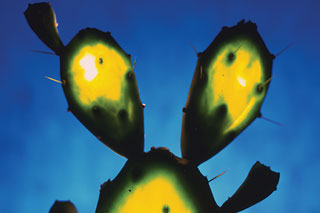
But there was one thing she had always wanted to know more about, from her childhood. Alcantar grew up in Mexico, and one afternoon she was talking to her grandmother about what she’d learned in chemistry about substances used for cleaning. Her grandmother knew all about it, explaining that as a child, she would use water in which cactus had been boiled to separate the sediment from dirty river water.
There was another thing about Alcantar’s grandmother and her mother. They never gave her the full answer to her questions, only little clues, to push her to find the answers for herself.
Decades later, when Alcantar set up her lab in the Department of Chemical Engineering, she decided to work with her students to figure out exactly how the cactus – prickly pear to be precise – worked as a water purifier.
Alcantar and her team learned that the slimy meat inside a cactus pad – called mucilage – contains dozens of polysaccharides, or sugars, that act as dispersants. The sugars bind to the foreign substances in the water, turning them into removable clumps, or “flocs.”
Today, a decade after that work began, Alcantar is a full professor and the patented cactus research has spouted more than a dozen separate investigations with collaborators.
In 2010 Alcantar received a $100,000 National Science Foundation grant to study how the Haiti earthquake disrupted water supplies and whether the cactus treatment could have been used to clean heavy metals and bacteria from the water. They learned that it could.
After the Deepwater Horizon oil spill, which oil company BP tried to manage by using millions of gallons of a chemical dispersant, she received funding to investigate the use of nontoxic cactus as an oil dispersant. It worked.
Last year, Alcantar and a postdoctoral researcher formed a company around aquaculture research with Mote Marine Laboratory in Sarasota.
Mote researchers sought her help to deal with the smelly compounds that formed on the fish they farmed. The bacteria would grow in the recirculating water and produce compounds that were absorbed into the fish skin, tissue, and eggs. At harvest, they would use fresh water to purge the fish of the compounds, but it took 4-6 weeks, used a lot of water, and stressed the fish.
By adding cactus mucilage in the form of beads or a powder to the recirculating water, they could help keep the water clean and reduce the purging time to about a week. The new company, Water Health and Sustainability LLC, was created to produce units that other fish farmers could use. “We’ve got 1,500 fish farmers in Florida. It’s a good market,” Alcantar says.
The next project? Using cactus mucilage to treat Alzheimer’s disease. It involves the use of an inhalable form that would dissolve the destructive plaques that form in the brains of those with Alzheimer’s.
And there are others: using cactus to create biocompatible materials for cell regeneration and putting mucilage into beets to absorb contaminants.
“I get emails every day” from people around the world with questions about how to use cactus to clean water, she says. Much of her work has focused on determining the concentration levels needed to deal with different contaminants. But even if she doesn’t know the details of the contamination, she has an answer.
It still works in the old-fashioned form, she says, just by boiling cactus and mixing that water with the contaminated water. Like her grandmother did as a child in Mexico.
Water and fertilizer for the developing world
You could call it a toilet.
Speaking scientifically, USF associate professor Daniel Yeh calls it an anaerobic membrane bioreactor.
But to Yeh, an environmental engineering researcher, it’s even more. It’s part of the water, energy, food nexus that will become increasingly important as the global population expands.
The elements are interconnected, and becoming more so as the energy required to grow food and meet water needs increases. But what if one system could treat waste and produce both water and fertilizer, all with minimal energy use and expense?
This is what Yeh and his USF collaborators have been working on for the past 15 years. They call it the NEWgenerator; NEW because of the nutrients, energy, and water the device produces. The system is up and running in India, in a city like many worldwide that could not build the kind of energy-intensive sanitation system so common in the developed world.
The systems that most of us depend on, with miles and miles of pipelines running to and from big treatment plants “cost more than the GDP of some countries,” Yeh says.
His NEWgenerator, however, sits in a modified shipping container and can be moved from place to place with a forklift.
Here’s how it works: The waste and wastewater enter a small tank, where microbes feed on it and produce a biogas containing methane, which can be used to create energy. The waste they leave behind is filtered through a membrane that removes bacteria and viruses, producing water for irrigation. The membrane also captures nitrogen and phosphorous, key plant nutrients.
The device set up in India channels nutrients into a small hydroponic garden, including aromatic plants, attached to the side of the container. It’s all powered by solar panels on the roof.
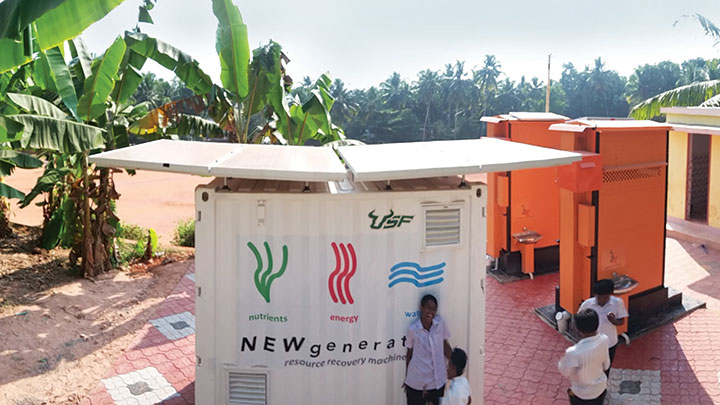
Yeh began his work while a postdoctoral researcher at Stanford University in 2002 working with Craig Criddle, who had a vision for creating an energy-neutral waste water treatment process. Yeh came to USF in 2004 and continued the work with his graduate students.
He and his team have received support along the way, including a $50,000 entrepreneurship prize from the Cade Museum in Gainesville, $100,000 from the Bill and Melinda Gates Foundation, and $200,000 from the Indian government. The Gates involvement came with a special kind of consulting.
They focused on failure, Yeh says. As the device went through its day-to-day paces in the coastal city of Trivandrum, Gates advisors continually wanted to know what was going wrong, seeking bugs to fix. “They know the value of failure. It’s how you learn,” Yeh says.
But the system proved itself, Yeh says. “If anything, we overdesigned it, so it would not fail.” He credits Robert Bair, a student who played a key role in designing and building the system, and accompanied it to India to monitor the roll-out.
“The person who built it was trouble-shooting on the spot,” Yeh says.
To be sure, there were some problems. In one case, children were taking plants and parts from the hydroponic garden. They believe it was children because things went missing only from the lower sections. So, they changed the outside design.
Now Yeh is working with an Indian company to sell the devices across India. The company produces special self-cleaning toilets, but they need water to flush and weren’t selling in the water-scarce areas. “This is where we come in,” Yeh says.
Yeh and his team are also working with Gates to develop international standards for their “reinvented toilet,” to make it easier to manufacture from country to country. Other partnerships are in the works in South Africa and China.
“Our research is going out of the lab and into the field,” Yeh says. The researchers have several patents pending and are working on licensing agreements. “We’re at a very exciting place now.”
It’s exciting for many reasons. Commercial success, of course. But Yeh sees more. It may be hard to talk seriously about a toilet, but children die every day across the world from water-borne illnesses, he says, and a good toilet can save lives.
